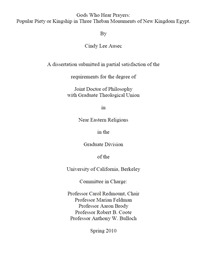
For the past 50 years, Thutmose III's and Ramesses II's Eastern Temples at Karnak and the Eastern High Gate of Ramesses III's mortuary temple at Medinet Habu have been accepted as monuments that fulfilled the religious needs of the general populace of ancient Thebes based on Charles Nims' assessment of these monuments. Thutmose III's Eastern Temple was believed to have been built as "a perfect place of hearing" and the two Ramesside monuments both had representations of a god bearing the title "God who hears prayers." To date there has been no comprehensive study of the context of these three "places of hearing." In this study, is asked and answered the following three questions. 1) How do the two "god who hears prayer" scenes fit into the iconography of their respective temples? 2) How did the iconography of the "places of hearing," i.e., the two Eastern Temples at Karnak and the Eastern High Gate at Medinet Habu, encourage the Theban populace to use them for their the spiritual needs? 3) If the iconography of the Eastern Temples at Karnak and the Eastern High gate at Medinet Habu did not encourage use by the populace, what was their purpose?
In Chapter 2 is a review the scholarly literature on personal piety and popular religion. Previous works have catalogued sites believed to be loci for personal piety and have studied the archaeological evidence in the form of personal monuments and graffiti. No iconographic studies of the sites, however, have been carried out. In Chapter 3 are examined sites that have yielded textual, iconographic or archaeological evidence of use by the populace in their attempt to contact deities and deified kings to establish a baseline for comparison with the three monuments.
In Chapter 4 is present an in-depth analysis of the two Eastern Temples at Karnak and the Eastern High Gate at Medinet Habu. I investigate the relevant textual, iconographic and archaeological evidence for each temple to determine whether any of it relates to personal piety. I discuss the iconographic programs of the Eastern Temples at Karnak, incorporating both their original New Kingdom constructions, as well as later additions. At the Eastern High Gate at Medinet Habu the god "who hears prayer" is not the principle deity of the mortuary temple, the Theban Amun-Re, but rather the Memphite god Ptah. Therefore is discussed the decorative program of the temple proper in addition to the iconographic program of the High Gate. Is concluded by demonstrating that the Eastern Temples at Karnak and the Eastern High Gate at Medinet Habu show little to no evidence of serving the religious need of the Theban populace. Instead, a kingship ritual, namely the Sed festival, plays a major role in the decorative programs of all three monuments.
In Chapter 5 is discussed the evidence for the Sed festival, the various theories regarding its importance to kingship and its possible link to the king's role as high priest. Is also demonstrated the importance of Amun-Re, Ptah and Atum in the Sed festival celebrations of Thutmose III, Ramesses II and Ramesses II. I emphasize that the god who is given preference by the king during his Sed festival(s) is the same deity chosen to be the one "who hears prayer." Finally, are discussed specific aspects that illustrate the king's role as high priest and the divine nature of kingship. Is concluded the chapter by demonstrating that the function of these monuments was focused on the cultic role of the king.
In the final chapter, Chapter 6, is summarized the evidence and analyses. reinforced the conclusion that the three monuments I investigated, the two Eastern Temples at Karnak and the Eastern High Gate at Medinet Habu played no role in popular piety. To the contrary they focused on kingship and the king's role as divine high priest.

